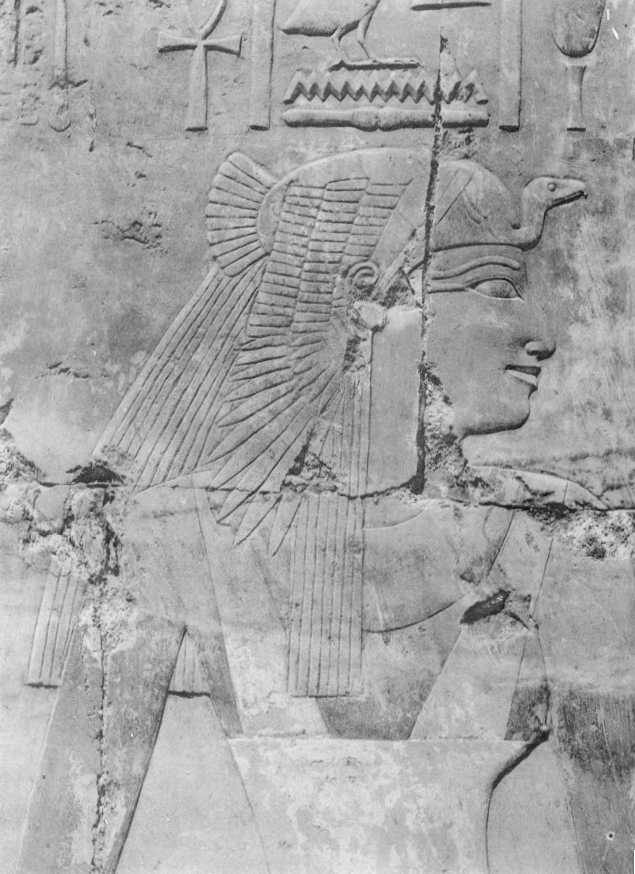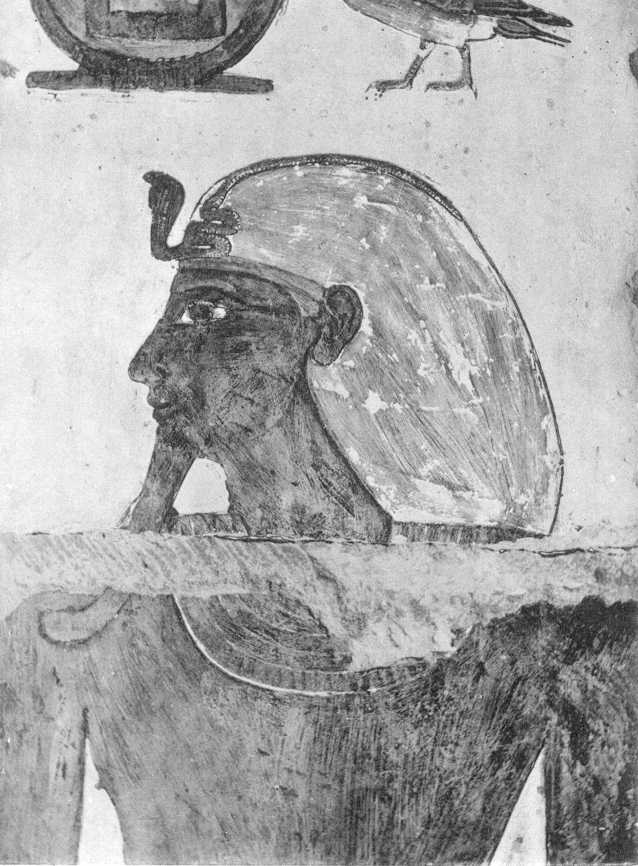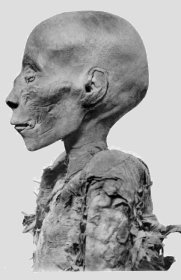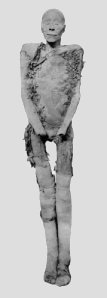|
Maat-ka-Ra Hatshepsut |
last update:
09.06.2009
|
| |
Family
|
|
Hatshepsut was born into into the early 18. Dynasty
during the reign of her father king Aa-cheper-ka-RA Thutmosis I (on the right, photo of Howard Carter, Plate XII, from Naville, "Temple
of Deir el-Bahari", 1894 -1908) by the "Great Royal Wife" Ahmose (left, H. Carter, Plate XI, from
Naville). Since it is possible that the kings maintained a mobile court at
that time and traveled through the country to exercise there on the spot -
like in Franconia under king Charles the Great - the place of birth of
Hatshepsut is not known. However, one can assume that she was born in the royal residence
at Waset (= Thebes).
|
| Since its discovery in the cachette DB 320 the mummy called "Unknown Man" (JE
26217, CG 61065; see the following photos) the identification of this mummy is
still a matter of dispute. First, the mummy was thought to be that of Pinudjem I
because the coffin had been reinscribed for the priest-king. But later it was
discovered that the original owner had been Thutmosis I. Thus, Maspero believed it to be the mummy of Thutmosis
I. Most likely, the reason for this assignment was the striking resemblance between
this mummy and those of Thutmosis II (see photos below) and Thutmosis III.
|
| The CT-scans of the mummy of the "Unknown Man"
(JE 26217, CG 61065), which were done recently by the SCA, suggested that
this man died between an age of 25 to 35 years. Furthermore, the scans revealed
a piece of metal about 2 cm large in the right thorax - probably an arrowhead. Since Thutmosis I.
probably died at an age of about 50 and historical records do not indicate that
he died in a battle, the mummy of the "Unknown man" is with great certainty not
the mummy of Thutmosis I. |
| According to Ikram and Dodson
(1998) it was also considered possible that this mummy could be that of Ahmose-Sipairi
who was also suggested to be perhaps the father of Thutmosis I.
|
| Left: mummy of the Unknown Man (JE 26217, CG 61065; Catalogue
du Musée de Caire, plate XX - XXII),
center: two photos of the head; right: mummy of Thutmosis II (Museum
Cairo, CG 61066; JE 26212; Catalogue du Musée de Caire, plate XXIII). |
| Up to now it was not possible to identify the body of
Hatshepsut's father among the mummies discovered so far - also the mummy of her
mother is missing. |
| The "Great Royal Wife" and "King's Sister" Ahmose, mother of
Hatshepsut and a sister called Neferubiti presented on an own
page. |
|
As bodily or at least as half-brothers and -sisters (see Genealogy) the brothers
Amenmose and Wadjmose
(tomb of Paherj, Elkab; Sethe, Urk. IV, 108-110) and an older sister, Neferubiti (also mentioned under the name Achbet-neferu)
are testified. According to Ratié (1979, S. 24) Ahmose was perhaps the mother of several
other princes named Binpu, Ramose, Nekenkhal, Aahmosis. |
|
Since also the (half-)sister of Hatshepsut, Neferubiti, died early,
Hatshepsut has been the only child of king Thutmosis I and his "Great
Royal Wife", Ahmose, that survived.
|
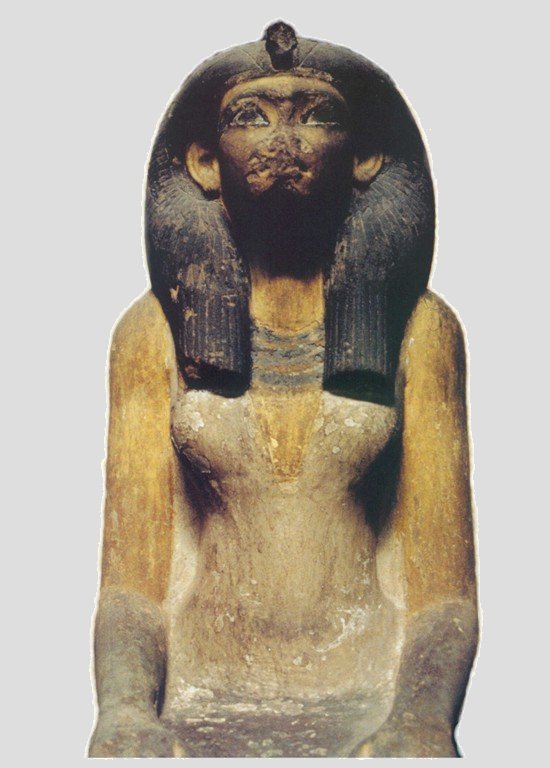
|
| Mutnofret (Mutneferet)
Besides the "Great Royal Wife", Ahmose, Thutmosis
I had
a 2nd wife, the "King's Mother" Mutnofret I (the statue left shows
her wearing the royal
uraeus; painted limestone, Egyptian Museum, Cairo No 572; text Sethe, Urk. IV,
143). The title proves that she has been the
mother of his successor, king Thutmosis II.
According to Troy (1986) the following titles are testified:
King's Mother (mwt nsw)- statue Cairo No. 572;
situla of Sitamun I (daughter of Ahmose I and Ahmose-Nefertari); fragment of
stela Cairo 34031;
King's Wife (Hmt nsw) - statue Cairo No. 572;
temple Thutmosis III, Deir el-Bahari;
King's Daughter (sAt nsw) - statue at 8th Pylon,
Karnak;
fragment of stela Cairo 34031;
King's Sister (snt <nsw> mryt.f) -
statue of Thutmosis II at 8th Pylon, Karnak;
Both titles, King's Daughter and King's Sister suggest that she
may have been a daughter of king Ahmose I and, therefore, a (half-)sister of Amenhotep
I. |
| A more detailed discussion of age and duration of the reign of Thutmosis II is giben on the page Regent. |
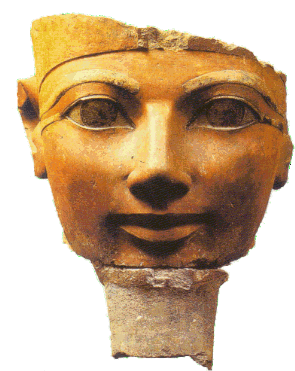
painted limestone head of Hatshepsut, found at Djeser djeseru, Deir
el-Bahari;
today exhibited in the Egyptian Museum, Cairo
Height: 61 cm;
Width: 55 cm |
Hatshepsut
has most
likely spent her childhood together with brothers and sisters and half- brothers and
-sisters in the royal harem, where she probably, as usually for a princess, was prepared for the position of a king's wife. From
the days of her childhood we know her nurse,
Sit-Ra (also known as Inet),
who not only nursed young Hatshepsut but also accompanied her during the first years of the childhood.
Obviously, a long-lasting, intimate relation developed between her and
Hatshepsut, so at least the nurse was allowed to build a simple tomb (KV
60) in the Valley of Kings near Hatshepsut's own royal tomb (KV 20).Since
Hatshepsut as mentioned above was the only child of Thutmosis I and Ahmose
that survived, inevitably her marriage with her half-brother Thutmosis II
was on schedule. |
| Neferu-Ra
-> see separate page |
| A younger child of Hatshepsut?
|
| There is no direct evidence for a 2nd, younger child of Hatshepsut.
However, the titles on some statues of tutors of princess Neferu-Ra could be
interpreted from that point of view that there was a younger child. |
| Thus, Ahmose Pennechbet wrote in his biography in Elkab that he had educated
the "elder daughter, the royal daughter" [called] Neferu-Ra ("jw
Sd.n=j sA(.t)=s wr.t sA.t nswt Nfr.w-Ra mAa-xrw"; Urk. IV 34, 15).
|
| On an tutor´s statue of Senenmut (Chicago Field Museum, No. 173800) stands
according to Roehrig "I fed the eldest daughter of the king ("jw
Sd.n=j s3.t nswt smswt", i.e. word-for-word "the eldest royal
daughter"), God´s Wife Neferu-Ra. In contrast to Ahmose Pennechbet which wrote
literally "her great daughter" ("..sA(.t)=s wr.t
.."), called Senenmut her literally as a "elder king's daughter ("...s3.t nswt smswt
.."). |
| Furthermore, Senimen describes his position on some bricks
found in his tomb, TT252, as (Urk IV, 418): "Wab-priest of Neb-pehti-Ra (=
Ahmose), Senimen, [Tutor of] God's Wife Neferu-Ra, Senimen, [Tutor of] God's
Wife Hatshepsut, Senimen, Custodian of the King's Daughter, Senimen". Some
authors, among them Lepsius (LD III, 25) read instead of God's Wife Daughter of
God's Wife Hatshepsut (sA.t Hm.t nTr). |
| Several Egyptologists, for example, Ratié (1979) and Desroches Noblecourt (2002) belief that Merit-Ra Hatshepsut II (see
below), the "Great Royal Wife" of Thutmosis III, was this unknown daughter of
Hatshepsut und her husband, Thutmosis II. |
| Thutmosis III
|
| |
| The stepson of Hatshepsut and her successor on the throne, Thutmosis
III, originated from the connection of her husband, Thutmosis II, with his
"concubine" Isis (right the only statue of Isis that had
survived, black granite, today Egyptian Museum, Cairo,
JE 37417 = CG 42072). |
| |
| The mother of Thutmosis III originated obviously not from royal family, but was probably a
friend from his youth, which had grown up together with the children of Thutmosis
I at the royal court. These girls grown up in the royal woman house probably came
from important families and were called "Ornament/Decoration of the King". In the few
representations, which have survived of Isis, she carries no title which
indicates a relationship with the royal family. On the seated statue
(right) that was found in the cachette at Karnak, the text (beginning beside
her right knee) addressing Isis who carries here above a wig
something like a crown with two Uraeus snakes reads: |
| "The Good God, Lord of the Two Lands, Men-Cheper-Ra (Thutmosis
III), beloved of Amun, the Lord of all Thrones of the Two
Lands, he made his monument for his mother, the royal mother Isis, justified."
|
| |
All other titles, e.g. that of a "God's wife" and
that of a "Great Royal Wife", which are shown in the temple of Thutmosis III probably have been lent to her
posthumously by her son.
In contrast, there are no inscriptions that point
to her actual origin.
|
| |
| Obviously, Thutmosis III does not originate - like his father and grandfather - from the royal blood line.
His right to the throne was quite small, compared with possible descendants from the
Ahmoside family. Thus, a marriage with the hereditary princess Neferu-Ra, who had already taken over the title of a "God's
Wife" from her mother, would have been inevitable for a legitimacy of his right to the
throne - if one accepts the hypothesis that the right to the throne was
achieved by a marriage with the "hereditary princess". |
|

|
|
However, there are no records indicating a marriage of Neferu-Ra and Thutmosis III, although Neferu-Ra probably achieved a
marriageable age. Perhaps, Hatshepsut
herself has hindered this marriage - if the "hereditary princess"-hypothesis applied, then
the right to the throne of Thutmosis III was larger than her own.
|
Merit-Ra Hatshepsut II
Occasionally, the "Great Royal Wife" of Thutmosis III,
the mother of his son and successor Amenhotep II,
is said to be a daughter of Hatshepsut. However, her origin is not determinable
with certainty.
|
| Since she never held the title "King's Daughter" (sAt nswt) on the monuments which have survived, an origin of
Hatshepsut and Thutmosis II is improbable. On a staff found in the tomb of Amenhotep
II she is mentioned with the queenly titles "God's Wife, Great
Royal Wife, Lady of the Two Lands and King's Mother". Probably, she took over
title and function of a "God's Wife" after the death of Neferu-Ra.
|
|
